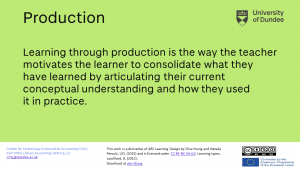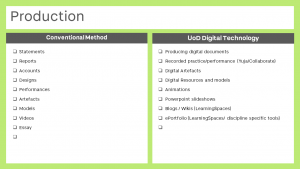Introduction
Today’s topic will give you the opportunity to think about learning through Production, to help you consider how you could enrich and motivate learners to consolidate what they have learned and how they used it in practice.
Learning through Production can have many important benefits for learning. First of all, it encourages creativity, activity and interactivity and allows for students to take on more responsibility for their learning central to effective knowledge construction (Biggs, 2003). It also provides students with an opportunity to articulate, reflect and have considerable scope to influence the focus and pace of their work. For example, giving students greater control over their learning as creators increases active engagement, learner autonomy, and increased ownership (Wheeler, 2013).
As we saw in Practice, designing learning activities requires considerable thought and organisation to make the online experience work well. Consider then, how you would keep your students motivated and engaged online by evaluating the concepts of their practice through Production. For example, you might want to think about integrating online collaborative groupwork or allow your students learners the opportunities to think independently for producing a presentation or a portfolio of work of what they have learned.


Moving online
There are many ways to motivate and empower learners to become producers of their own content, but it is important that you have the knowledge and awareness of the tools and technologies that are available (GCU Curriculum Design & Development Toolkit for Staff p15). Another consideration to factor is ensure that your students are given adequate time to acquire new skills for learning a new digital tool. Think about what this would involve and how would you implement student support and opportunities for practice before the start date and over the duration of a module.
Look at the back of the learning type card for Production, notice that it offers a choice of tools for your learners. Think about the constructive alignment and what you want your students to achieve to develop their concepts of practice. There are many kinds of learning activities that work well for this in the blended and online learning modes, some ideas could be:
- Video and audio: Allow students to work to produce a video or audio assignment. They could do this either independently, or as a small group.
- E-portfolio: Formatively assess continuous learning of the product as curated by the student, that is built up incrementally. Here students monitor their progress of their learning by mapping against competency-based framework criterion
- Online groupwork – blogs and wikis: Assign students to create a collaborative (social) working space and assign authentic activities.
- Online groupwork – producing digital documents: Allow co-authoring opportunities. This can easily be set-up in OneDrive and shared through the virtual learning environment synchronously capturing the learning process in real time.
Dundee Tools
- My Dundee: Journals,
- YuJa: Provide and engage students by giving them a space to create digital audio and video artefacts.
- LearningSpaces: Offer blog, wiki, reflective and e-portfolio spaces.
- 0365 for Education Word, PowerPoint and OneNote
- Audacity: If you have students who’d rather do more with audio than recording on their phones and uploading to Yuja, then point them to Audacity – on Apps Anywhere – or downloadable as it’s OpenSource.
Over to you
Production is usually associated with summative and formative assessment and requires considerable thought and organisation for ensuring that the learning activities effectively engages the student. In the comments box below share and reflect on the following:
- How would you support and keep your students motivated and engaged online?
- How would you formatively assess continuous learning and provide feedback?
- What do think about giving your students spaces for them to produce artefacts to develop concepts of their practice and show what they have learned?
- What measures would you put in place to evaluate their learning?
- If you have students with hearing or visual issues, how could you ensure they’re not excluded from others’ contributions, for example to a class podcast? What should your students who are creating artefacts be doing for universal accessibility?
Other Dundee Resources
In the LearningX looking at Innovative Assessments, we had a range of different approaches to assessment. We’ll be updating this soon – and keep an eye out for the new recipe cards that are on their way.
References
Biggs, J. (2003). Teaching for quality learning at university. Buckingham: Open University Press.
Houston, S. (unpublished) Curriculum Design and Development Toolkit for Staff. Glasgow Caledonian University
Wheeler, S (2013, September 1) Learners as Producers http://www.steve-wheeler.co.uk/2013/09/learners-as-producers.html Accessed June 26th, 2020
Young, Clive. (2020, April 21) Moving activities online with ABC – take it further. https://blogs.ucl.ac.uk/abc-ld/moving-activities-online-with-abc-take-it-further/ Accessed June 22nd, 2020
YuJa (no date) Video assignments and student recording. https://www.yuja.com/video-assignments-and-student-recording/ Accessed June 28th, 2020

